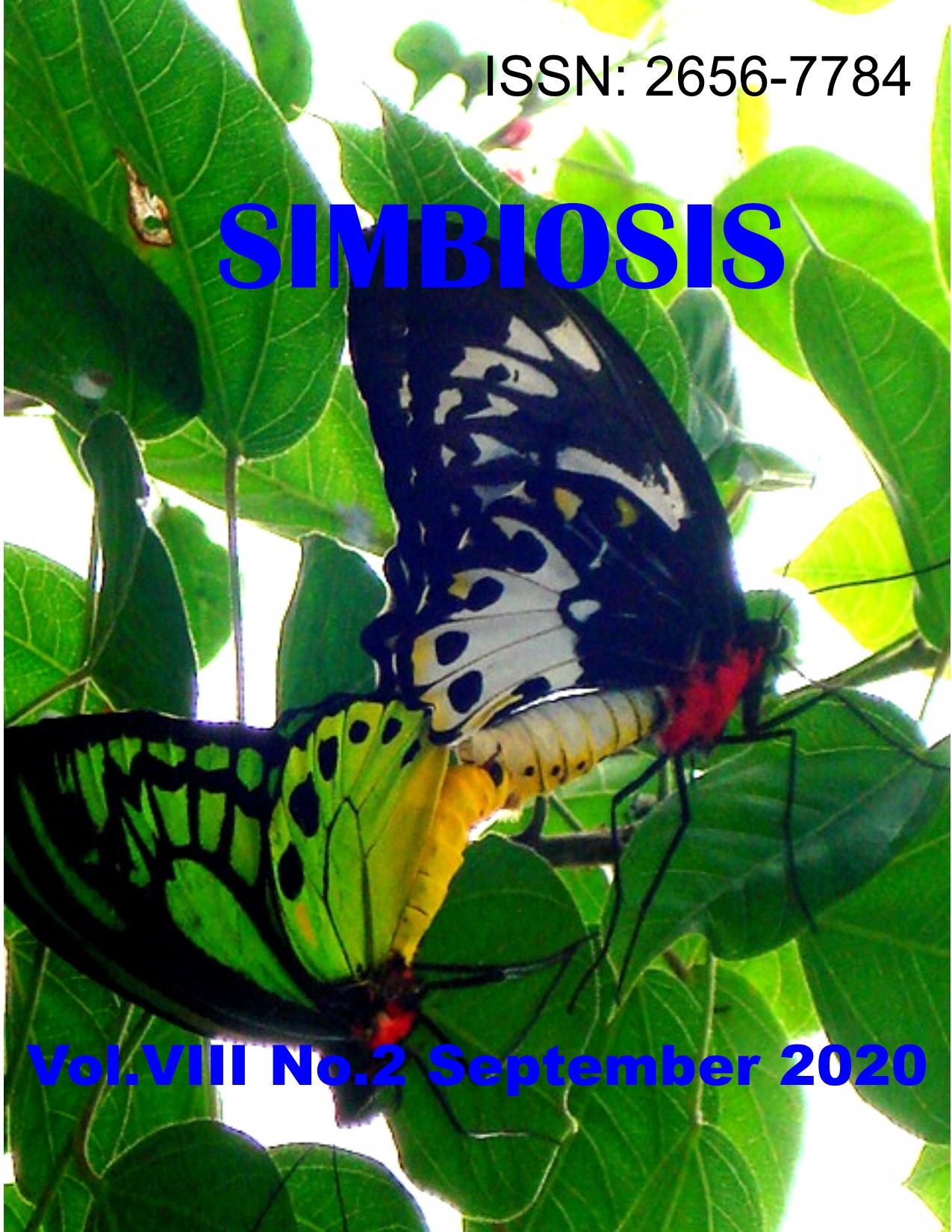EFEKTIVITAS Trichoderma asperellum TKD DENGAN MEDIATOR PUPUK KANDANG UNTUK MENGENDALIKAN PENYAKIT LAYU FUSARIUM PADA TANAMAN CABAI MERAH (Capsicum annum L.)
Abstract
Red pepper is agricultural products in Indonesia which is often attacked by fusarium wilt disease due to the fungus Fusarium oxysporum f.sp. capsici, so in this study aims to control of fusarium wilt disease using Trichoderma asperellum TKD with mediator of manure. Method in this study is RAL (Completely Randomized Design) with 7 treatments P1 = Control I (without treatment); P2 = Control II (F.oxysporum f.sp. capsici (disease)); P3 = disease + T. asperellum TKD 10 mL; P4 = disease + T. asperellum TKD 20 mL; P5 = disease + T.asperellum TKD 30 mL; P6 = disease + T. asperellum TKD 40 mL; P7 = disease + T. asperellum TKD 50 mL. The results showed that T.asperellum TKD was able to inhibit F.oxysporum f.sp. capsici in in vitro by 100%. The highest percentage of fusarium wilt disease (100%) is shown in plants that are only given F.oxysporum f.sp. capsici and without T. asperellum TKD, as well as plant height, total of fresh and dried leaves in plants added by T. asperellum TKD is better compared to plants that are not given T. asperellum TKD. The best plant height, number of freh leaves, and lowest number of dry leaves found in plants with 50 mL of T.asperellum TKD.
Keywords: biocontrol, pathogenic fungi, Trichoderma asperellum TKD
Downloads
References
Darmayasa, I.B.G., Sentana, P., Sujaya, I.N and Sukrama, I.D.M. 2014. The Trichoderma asperellum TKD Filtrate Potency in Reducing Contaminans of Aflatoxins B1 Produced by Aspergillus flavus FNCC 6109 on Concentrate Feed. International Journal Of Pure & Applied Bioscience. 2(6) : 20-26.
Darmayasa, I.B.G and Oka, I.G.L. 2016. A Study on Inhibitory Effect of Trichoderma sp. TKD on Aspergillus flavus FNCC6109 and Its Molecular Identification. International Journal Of Pure & Applied Bioscience. 4(2): 103-110.
De Cal, A., Garcia, R. L. and Melgarejo, P. 2000. Induced resistance by Penicillium oxalicum Against Fusarium oxysporum f.sp. lycopersici: Histological Studies Of Infected And Induced Tomato Stem. Phytopathology. 90(1): 260-268.
Hajieghrari, B., Giglou, M.T., Mohammadi, M.R. dan Davari, M. 2008. Biological Potential of Some Iranian Trichoderma Isolates in The Control of Soil Borne Plant Pathogenic Fungi. African Journal of Biotechnology. 7(8): 967-972.
Henki, W. 2013. Kajian Pemanfaatan Lahan Sawah Di kecamatan Kuantan Tengah Kabupaten Kuantan Singingi. Universitas Pendidikan Indonesia. Jakarta.
Kementrian Perdagangan Republik Indonesia. 2019. Analisis Perkembangan Harga Bahan Pangan Pokok Di Pasar Domestik dan Internasional. Kemendagri. Jakarta.
Laurensius, L. 2012. Pengujian Pupuk Organik Agen Hayati (Trichoderma sp.) Terhadap Pertumbuhan Kentang (Solanum tuberosum L.). Jurnal Penelitian Pertanian Terapan. 12(2) : 115-124.
Nisa, C. 2018. Pengujian Formulasi Trichoderma sp. Terhadap Pencegahan Patogen Fusarium Oxysporum Penyebab Layu Pada Cabai Rawit (Capsicum frutescens) Secara In Vivo. Universitas Islam Negeri Maulana Malik Ibrahim Malang. (Skripsi). Tidak dipublikasikan.
Putra, I.M.T.M., Phabiola, T.A. dan Suniti, N.W. 2019. Pengendalian Penyakit Layu Fusarium oxysporum f.sp. capsici pada Tanaman Cabai Rawit Capsicum frustescens di Rumah Kaca dengan Trichoderma sp. yang Ditambahkan pada Kompos. E-Jurnal Agroekoteknologi Tropika. 8(1) : 103-117.
Sari,W., Suryo, W., Ali, N., Abdul, M. dan Roedhy, P. 2017. Keanekaragaman dan Patogenisitas Fusarium spp. Asal Beberapa Kultivar. Jurnal Patologi Indonesia. 13(6) : 216-228.
Siregar, R.S., Cik, Z. dan Saffrudin. 2018. Pengaruh Pemberian Dosis Trichoderma sp. Dan Jenis Pupuk Kandang Terhadap Pertumbuhan Dan Produksi Tanaman Kacang Panjang (Vigna sinensis L.). Journal Agricultural Research. 14(2) : 21-34.
Ullah,S., Naz, F., Fiaz, M., Sher, H., Hussain, S., Ahmad, S. and Khalid, A.N. 2018. In Vitro Evaluation of Commonly Available Fungicides Against Three Fungal Isolates. Plant pathology & Quarantine. 8(1) : 67-77.
Wongpia, A. and Lomthaisong, K. 2010. Profiles of Chilli Pepper (Capsicum annuum) Leaves in Response to Fusarium oxysporum Infection. ScienceAsia. 36(1): 259 – 270.

This work is licensed under a Creative Commons Attribution 4.0 International License.










